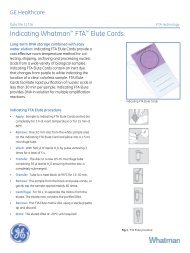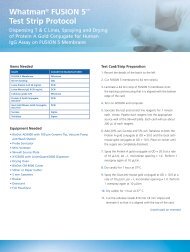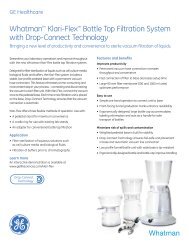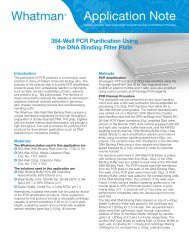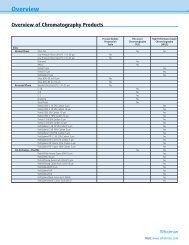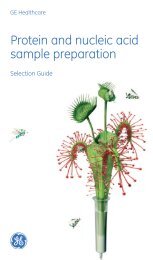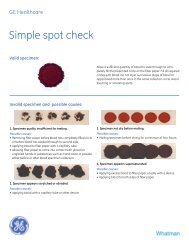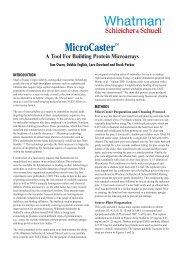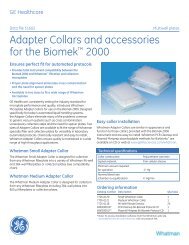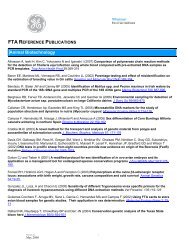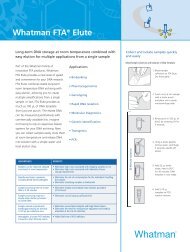Serum Biomarker Chip Datasheet - Whatman
Serum Biomarker Chip Datasheet - Whatman
Serum Biomarker Chip Datasheet - Whatman
Create successful ePaper yourself
Turn your PDF publications into a flip-book with our unique Google optimized e-Paper software.
Two-Color Labeling &<br />
Detection Kit<br />
The Two-Color Labeling and Fluorescent<br />
Detection Kit is designed to label two protein<br />
samples. The labeled proteins are<br />
pooled and probed against arrayed antibodies<br />
in a competitive binding assay, and<br />
detected using indirect fluorescence.<br />
• Highly efficient and uniform labeling<br />
of complex serum samples<br />
• Reproducible labeling and signal detection<br />
• Stable, robust and fast non-enzymatic<br />
procedure<br />
• Reduces pH dependency of labeling<br />
efficiency<br />
• System solution includes labeling<br />
reagents, fluorescent conjugate and<br />
bench-friendly protocol<br />
The kit is intended for use with two-pad<br />
FAST Slides, including the <strong>Serum</strong><br />
<strong>Biomarker</strong> <strong>Chip</strong>. The kit contains the<br />
Universal Linkage System (ULS)<br />
Labeling and Detection Procedure Overview<br />
chemistry to label samples containing<br />
approximately 250 µg of protein in serum,<br />
plasma, or a whole cell lysate. The kit is<br />
designed to label two different protein<br />
samples, each with a different hapten.<br />
Sufficient labeling reagent is provided to<br />
perform a hapten swapping experiment.<br />
Benefits of the two-color<br />
dye-swap assay<br />
• Accounts for hapten-specific differences<br />
in either Biotin-ULS or Fluorescein-<br />
ULS labeling efficiencies<br />
• Averages differences in antibodyantigen<br />
binding interactions caused<br />
by steric hindrance<br />
• Minimizes chip-to-chip variability – includes<br />
an internal control within the assay<br />
The first pad on the slide is probed with a<br />
mixture of two different protein samples,<br />
each labeled with a different hapten; the<br />
second pad is probed with the same two<br />
protein samples but with the haptens<br />
reversed. The normalized intensity for each<br />
Sample A Sample B Sample A Sample B<br />
Block slide with<br />
S&S Blocking Buffer<br />
for 30 min<br />
at room<br />
temperature<br />
Mix 1<br />
Mix 2<br />
element of each pad is calculated as the<br />
average of the biotin- and fluoresceinlabeled<br />
derived intensities from a two-pad<br />
experiment. The ratio between the signal<br />
intensity at each spot corresponds to the<br />
concentration ratio of the proteins found in<br />
the two samples. This method is attractive<br />
for antibody chips as it takes into account<br />
any hapten-specific differences in antigenantibody<br />
interactions.<br />
The use of the ULS labeling system minimizes<br />
background by using indirect fluorescence<br />
detection, labels multiple amino<br />
acids, and requires no additional materials<br />
or reagents.<br />
Label serum proteins with<br />
Biotin-ULS ( ) and<br />
Fluorescein-ULS ( )<br />
for 2-6 hours at 42 °C<br />
Terminate reaction<br />
and remove unbound<br />
ULS reagent<br />
with spin columns<br />
Pool Samples<br />
Incubate labeled proteins<br />
with <strong>Serum</strong> <strong>Biomarker</strong> <strong>Chip</strong><br />
for 4 hours to overnight at room temperature<br />
W H A T M A N S E R U M B I O M A R K E R C H I P D A T A S H E E T<br />
Wash 6X to remove<br />
unbound proteins




